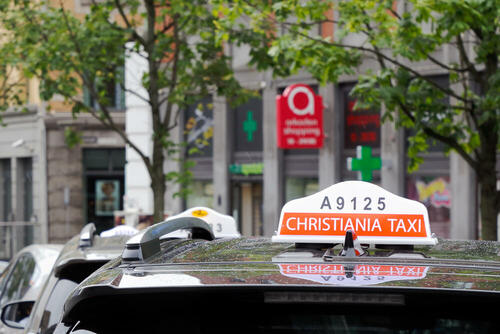This is one of the main findings in a new TØI and Fafo report, which presents trends in the Norwegian taxi market in the period from the re-regulation in November 2020 to March 2023. The prices have also increased.
The re-regulation of the taxi market was the biggest regulatory change in the taxi markets in Norway since the 1940s and was carried out in the middle of the pandemic. The effect on the taxi markets has been extensive.
The number of taxi licenses more than doubled
The deregulation resulted in a massive increase in the number of licences. In autumn of 2020 the were approx. 8,000 licenses in Norway. In April 2023, the number was over 18,100. The number of businesses was a good deal lower, which means that some of the businesses have become significantly larger. More cars were also registered, but not as many as the number of licences. This means that more permits have been taken out than those that have been activated.
The increase in the number of taxis is considerably greater in the more central areas of the country. The transition from a car fleet that mainly ran on diesel to more environmentally neutral vehicles with a high proportion of electric and petrol-hybrid powertrains has been particularly fast in central areas. At the same time, the car fleet has become older on average, so approx. 70 percent of the total car fleet is still powered by fossil fuels.
Turnover fell sharply
The turnover figures show a sharp drop from 2019 to 2020, and are probably due to the Corona pandemic, which placed major restrictions on the demand for taxi services. From 2020 to 2021, as restrictions were lifted and activity picked up again, a certain increase in turnover in the industry was seen, but only to a level that was still far below 2019.
It is worth noting that if the trips mediated by the taxi platforms and/or the trips carried out by the non-centrally affiliated taxi owners were not registered with the IRS, the turnover figures from 2021 may be underreported. On January 1, 2021, the central connection obligation was lifted and information on turnover was to be registered by "intermediaries of taxi services for license holders who are associated with the business", for example the taxi platforms and taxi centres, and no longer the individual license holder. However, it is unclear to what extent the taxi platforms currently operating in Norway carried out this third-party reporting in 2021.
Liberalization of the market opened up to new actors
With the deregulation, the need-testing of taxi licenses and the requirement that the taxis are connected to a taxi center were removed. The competence requirements were also moved from license holders to drivers. The license requirement for taxi owners and the ticket requirement for drivers were retained, and the requirement for the use of taxi meters and that cars used in passenger transport must be marked as taxis was continued.
Many new players have established themselves in the taxi market after November 2020, and several digital mediation platforms for taxi services have gained a foothold in the Norwegian taxi industry. Uber was able to expand its offer in Norway and attract more license holders, and new platforms such as Bolt, Ridel and Yango were established on a large scale. In addition, so-called "free riders" established themselves in the taxi market. There are independent, non-centrally affiliated taxi owners.
This development has also been seen internationally, but the impact on the markets has varied according to how the markets have been regulated in the past. In the book Taxi, Limousine, and Transport Network Company Regulation - Recurring Challenges, penned by m.a. TØI researcher Jørgen Aarhaug describes regulation and regulatory changes internationally.
The market adapts
The report finds that the taxi companies have adapted to uncertain times by, among other things, reducing costs related to cars, and one sees an older car fleet after the re-regulation. The development of the average purchase price in the car fleet also shows a shift towards less expensive cars.
The prices out to the public have become more differentiated. Prices for trips booked via an app or other form of pre-booking have decreased, and the price information for such trips is good. For trips advertised on the street, the system around price information is significantly worse.
Still demanding pay- and working conditions in the industry
Working conditions in the taxi industry were and still are difficult. Development is worse in the largest cities than in the rural areas.
The pay and working conditions for taxi owners and employed drivers who work for the digital platforms do not differ greatly from the traditional Norwegian taxi industry. The owners and the employed drivers in the various segments work mostly the same long days and weeks and earn about the same. Unpredictability related to income affects everyone.
The platforms established themselves with the same work organization as the traditional industry, where there are self-employed taxi owners who employ any hired drivers themselves. Therefore, one sees few and small changes in the owners' and drivers' pay and working conditions.
Algorithmic management provides unpredictability and little transparency
One challenge is the algorithm management that parts of the industry operate under. Like other types of platform companies in other industries, the taxi platforms argue that they are technology companies that offer their owners a market where they, as self-employed actors, can sell their services. At the same time, they exercise "algorithmic control" over their associated drivers by automatically assigning assignments, adjusting prices according to variations in demand, offering a range of financial incentives and evaluating and sanctioning drivers based on their behavior and customers' ratings of them. It provides unpredictability and little transparency. The "algorithmic management" can also have consequences for labor law assessments of the taxi owners' and drivers' forms of employment.
The report is part of a collaborative project with TØI and Fafo, and the project is financed by Fellesforbundet, Yrkestransportforbundet, Norwegian Taxi Association, the NFR project CODAPT, Fafo and TØI.
Read a summary of the report here
A survey of the development of the taxi market until the re-regulation in 2020 was documented in TØI report 1802/2020






